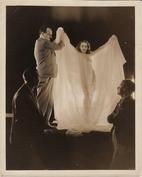Slavko Vorkapich Montage Sequences - Slavko Vorkapich
- Unseen Cinema Collection |
- 1928-1950 |
- 18 minutes |
- B&W |
- SOUND
Rental Format(s): Digital File
Maker: Slavko Vorkapich for films by others.
Original format: 35mm sound & silent film 1.33:1 and 1.37:1
Music: John Alden Carpenter, Ludwig von Beethoven, Robert Israel
Courtesy: Turner Entertainment, Paramount Pictures, Jugoslovenska Kinoteka
Awe-inspired by Griffith, Fairbanks, and Chaplin, Serbian émigré Slavko Vorkapich landed in Hollywood and proceeded to create a stellar montage-editing style that relied upon hyper-kinetic visual stimulation. Following the success of The Life and Death of 9413-A Hollywood Extra (1927), Vorkapich worked on studio montage sequences, and lucky for film history Vorkapich kept copies of these Hollywood experiments. His montages compress time and space while conveying maximum narrative content. Designed, shot and edited by Vorkapich, the inspired sequences illuminate his highly influential 'innocence of the eye' theories. -Bruce Posner
9 selected experiments:
"Skyline Dance" for Dorothy Arzner's Manhattan Cocktail (1928, 29 sec)
"Money Machine" for Rowland V. Lee's The Wolf of Wall Street (1929, 7 sec)
"Prohibition" for Ludwig Berger's Sins of the Fathers (1928, 1:32 min)
"Total Warfare" with John Hoffman for William Wellman's The President Vanishes (1934, 1:59 min) SILENT
"The Furies" for Ben Hect and Charles MacArthur's Crime Without Passion (1934, 2:50 min)
"Battle of Vitoria" for Robert Z. Leonard's The Firefly (1937, 1:52 min) SILENT
"Dora" for George Cukor's David Copperfield 1935, 1:41 min) SILENT
"Liberty" for Frank Capra's Mr. Smith Goes to Washington 1939, 3:30 min)
Abstract Experiment in Kodachrome (c. 1940-50sm 2:54 min)
Courtesy: Jugoslovenska Kinoteka
This dazzling stop-motion animation provided Vorkapich with a forum to demonstrate complex perceptual theories related to the persistence of vision and phi phenomenon. The dance of objects and their movements before the camera lens -somewhat similar to Oskar Fischinger's abstractions- illustrate many visual sensations playfully executed by Vorkapich. -Bruce Posner
Slavko Vorkapich (1892-1976), the Serbian-born artist, settled in Santa Barbara, California in 1925 as a portrait painter and by 1928, inspired by director Rex Ingram, entered Hollywood studios as a "montage" specialist. His name eventually became a noun describing the sequences for which he was famous. In later years, he made Pepsi commercials and lectured on principles of film art. -David Shepard













